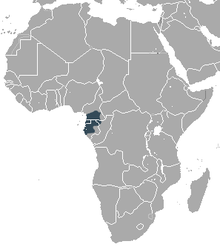
Black-and-white colobuses are Old World monkeys of the genus Colobus, native to Africa. They are closely related to the red colobus monkeys of genus Piliocolobus. There are five species of this monkey, and at least eight subspecies. They are generally found in high-density forests where they forage on leaves, flowers and fruit. Social groups of colobus are diverse, varying from group to group. Resident-egalitarian and allomothering relationships have been observed among the female population. Complex behaviours have also been observed in this species, including greeting rituals and varying group sleeping patterns. Colobi play a significant role in seed dispersal.

Bushmeat is meat from wildlife species that are hunted for human consumption. Bushmeat represents a primary source of animal protein and a cash-earning commodity in poor and rural communities of humid tropical forest regions of the world.
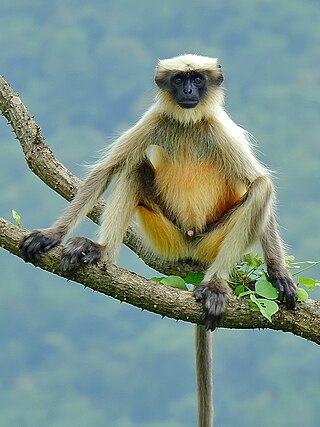
The Colobinae or leaf-eating monkeys are a subfamily of the Old World monkey family that includes 61 species in 11 genera, including the black-and-white colobus, the large-nosed proboscis monkey, and the gray langurs. Some classifications split the colobine monkeys into two tribes, while others split them into three groups. Both classifications put the three African genera Colobus, Piliocolobus, and Procolobus in one group; these genera are distinct in that they have stub thumbs. The various Asian genera are placed into another one or two groups. Analysis of mtDNA confirms the Asian species form two distinct groups, one of langurs and the other of the "odd-nosed" species, but are inconsistent as to the relationships of the gray langurs; some studies suggest that the gray langurs are not closely related to either of these groups, while others place them firmly within the langur group.

The king colobus, also known as the western black-and-white colobus, is a species of Old World monkey, found in lowland and mountain rainforests in a region stretching from Senegal, through Guinea-Bissau, Guinea, Sierra Leone and Liberia to the Ivory Coast. One of five members of the genus Colobus, the black-and-white colobuses, the king colobus is the westernmost species of the group on the continent of Africa. It eats mainly leaves, but also fruits and flowers. Though it is arboreal, it eats primarily on the ground. It lives in small groups consisting of 3 to 4 females and 1 to 3 males, plus their young. These groups maintain distance from one another through territorial calling.

The mantled guereza, also known simply as the guereza, the eastern black-and-white colobus, or the Abyssinian black-and-white colobus, is a black-and-white colobus, a type of Old World monkey. It is native to much of west central and east Africa, including Cameroon, Equatorial Guinea, Nigeria, Ethiopia, Kenya, Tanzania, Uganda and Chad. The species consists of several subspecies that differ in appearance. It has a distinctive appearance, which is alluded to in its name; the long white fringes of hair that run along each side of its black trunk are known as a mantle. Its face is framed with white hair and it has a large white tail tuft.
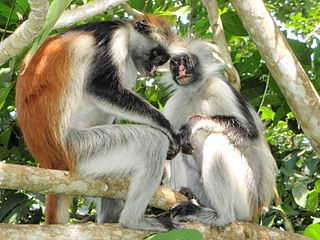
Red colobuses are Old World monkeys of the genus Piliocolobus. It was formerly considered a subgenus within the genus Procolobus, which is now restricted to the olive colobus. They are closely related to the black-and-white colobus monkeys, and some species are often found in groups with the blue monkey. The western red colobus is frequently hunted by the common chimpanzee.

Miss Waldron's red colobus is a species of the red colobus native to West Africa. It had previously been described as a subspecies of the western red colobus, P. badius. It has not been officially sighted since 1978 and was considered extinct in 2000. However, new evidence suggests that a very small number of these monkeys may be living in the southeast corner of Côte d'Ivoire. The IUCN Red List notes Miss Waldron's red colobus as critically endangered.

The western red colobus, also known as the bay red colobus, rust red colobus or Upper Guinea red colobus, is a species of Old World monkey in West African forests from Senegal to Ghana. All other species of red colobuses have formerly been considered subspecies of P. badius. It is often hunted by the common chimpanzee. In 1994, western red colobus monkeys infected many chimpanzees with Ebola virus when the chimpanzees hunted the monkeys as prey.

The Angola colobus, Angolan black-and-white colobus, or Angolan colobus is a primate species of Old World monkey belonging to the genus Colobus.

The collared mangabey, also called red-capped mangabey and white-collared mangabey, is a species of primate in the family Cercopithecidae of Old World monkeys. It formerly included the sooty mangabey as a subspecies. As presently defined, the collared mangabey is monotypic.

The red-eared guenon, also called red-eared monkey or russet-eared guenon, is a primate species in the family Cercopithecidae. It is native to subtropical and tropical moist lowland forests in Cameroon, Equatorial Guinea and Nigeria. It is listed as Vulnerable on the IUCN Red List and is threatened by habitat loss, illegal bushmeat hunting and pet trade.

The crested mona monkey, also known as the crowned guenon, crowned monkey, golden-bellied guenon, or golden-bellied monkey,, is a species of African primate in the family Cercopithecidae found in west central Africa.

The ursine colobus, also known as the white-thighed colobus, Geoffroy's black-and-white colobus, or the white-thighed black-and-white colobus, is a West African species of primate in the family Cercopithecidae.
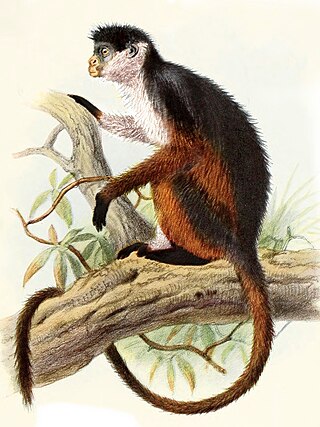
Pennant's colobus or Pennant's red colobus is a species of tree-dwelling primate in the family Cercopithecidae. It is endemic to tropical Central Africa. Three subspecies have traditionally been recognised but its distribution is peculiarly disjunct and has been considered a biogeographical puzzle, with one population on the island of Bioko, a second in the Niger River Delta in southern Nigeria, and a third in east-central Republic of Congo. It is found in rainforests and marshy forests. It is threatened by habitat loss and hunting for bushmeat.

The olive colobus monkey, also known as the green colobus or Van Beneden's colobus, is a species of primate in the family Cercopithecidae. Its English name refers to its dull olive upperparts. It is the smallest example of all colobine monkeys and is rarely observed in its natural habitat because of its cryptic coloration and secretive nature. It is found in the rain forests of West Africa, ranging from southern Sierra Leone to Nigeria. The IUCN Red List classifies the olive colobus as vulnerable, with the cause of its decline attributed to habitat loss and hunting. Though much of the land within the range of the olive colobus has been affected by human activities, it retains its ability to thrive in small degraded forest fragments.
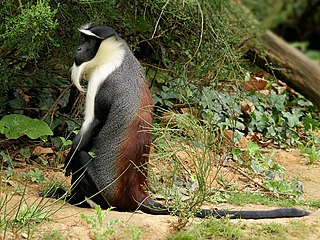
The Roloway monkey is an endangered species of Old World monkey endemic to tropical West Africa. It was previously considered a subspecies of the Diana monkey. The species is classified as Critically Endangered due to habitat loss and their continued hunting because of the bushmeat trade. The Roloway monkey is mainly an arboreal species, for the most part inhabiting forests in Ghana and some reserves in South-Eastern Côte-D'Ivoire. More specifically, studies have shown that C. roloway is primarily concentrated in the Tanoé forest of the Côte-D'Ivoire because of their heavy threats to extinction and lack of habitat. It is still difficult to gather data on wild subjects, as they have low populations in a vast forest, but they are a unique and vanishing species.

The Ugandan red colobus or ashy red colobus is an endangered species of red colobus monkey, recognised as a distinct species since 2001. There is disagreement however over taxonomy with many considering the Ugandan red colobus to be a subspecies. The Ugandan red colobus is an Old World monkey which is found in five different locations across Uganda and Tanzania.

The Niger Delta red colobus is a critically endangered species of colobus monkey endemic to the western part of the Niger Delta. It is threatened by hunting and habitat loss.

The Gran Caldera de Luba Scientific Reserve is a protected area of 51,000 hectares on the volcanic island of Bioko, a part of Equatorial Guinea. The dense rainforest is rich in plant and animal species including a high population of primates, some endemic to the reserve. Much of the reserve consists of pristine forest. However, the primate population is under threat due to growing demand for bushmeat coupled with lack of enforcement of the ban on hunting in the reserve.

Bouvier's red colobus is a species of colobus monkey rediscovered in the Republic of the Congo in 2015, after four decades without a confirmed sighting.

